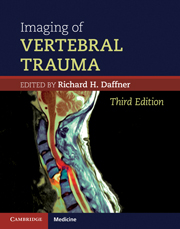Book contents
- Frontmatter
- Contents
- List of contributors
- Preface to the Third Edition
- Preface to the Second Edition
- Preface to the First Edition
- Acknowledgments
- 1 Overview of vertebral injuries
- 2 Anatomic considerations
- 3 Biomechanical considerations
- 4 Imaging of vertebral trauma I: indications and controversies
- 5 Imaging of vertebral trauma II: radiography, computed tomography, and myelography
- 6 Imaging of vertebral trauma III: magnetic resonance imaging
- 7 Mechanisms of injury and their “fingerprints”
- 8 Radiologic “footprints” of vertebral injury: the ABCS
- 9 Vertebral injuries in children
- 10 Vertebral stability and instability
- 11 Normal variants and pseudofractures
- Index
6 - Imaging of vertebral trauma III: magnetic resonance imaging
Published online by Cambridge University Press: 21 April 2011
- Frontmatter
- Contents
- List of contributors
- Preface to the Third Edition
- Preface to the Second Edition
- Preface to the First Edition
- Acknowledgments
- 1 Overview of vertebral injuries
- 2 Anatomic considerations
- 3 Biomechanical considerations
- 4 Imaging of vertebral trauma I: indications and controversies
- 5 Imaging of vertebral trauma II: radiography, computed tomography, and myelography
- 6 Imaging of vertebral trauma III: magnetic resonance imaging
- 7 Mechanisms of injury and their “fingerprints”
- 8 Radiologic “footprints” of vertebral injury: the ABCS
- 9 Vertebral injuries in children
- 10 Vertebral stability and instability
- 11 Normal variants and pseudofractures
- Index
Summary
Since the mid 1970s, MR imaging has reached the stage of a mature technology. It is indispensable for the diagnosis of a broad spectrum of vertebral and spinal cord pathology as well as the sequelae of trauma. While radiography and CT can reveal important detail about fractures and abnormal alignment, it became clear from the outset that MR imaging was unique in its depiction of intrinsic spinal cord injury [1–5]. As technical advances occurred, MR imaging became recognized for its value in assessing vertebral fractures and in demonstrating ligamentous disruption [6–8]. Spinal cord compression by bone fragments, disc herniation, and epidural or subdural hematomas could also be diagnosed [9]. Hemorrhagic contusion within the cord could be observed with serial examinations, which could reveal the onset of posttraumatic progressive myelopathy [10]. Furthermore, refinement of MR angiography (MRA) has provided adjunctive information about vascular structures (e.g., vertebral artery dissection or occlusion) [11,12].
The information gleaned from MR imaging, especially when supplemented by CT, has succeeded in significantly reducing the need for myelography [13]. The risks associated with myelography are increased in the setting of acute trauma, and it is now reserved for situations in which MR imaging is contraindicated, where the technical challenges of the MR examination result in suboptimal image quality, or for parts of the world where MR imaging is unavailable.
Technical considerations
A discussion of technique requires both an understanding of the logistics involved in the scanning of acutely injured patients in a safe manner and knowledge of the appropriate pulse sequences to achieve diagnostic efficacy.
- Type
- Chapter
- Information
- Imaging of Vertebral Trauma , pp. 72 - 87Publisher: Cambridge University PressPrint publication year: 2011



